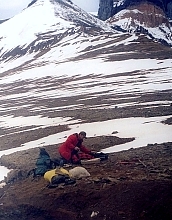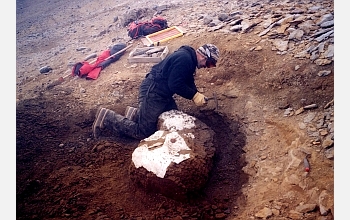All Images


Press Release 06-173
Volcanic Blast Likely Killed and Preserved Juvenile Fossil Plesiosaur Found in Antarctica

Skeleton to be unveiled at U.S. museum Dec. 13
Back to article | Note about images
 |
A mother and juvenile plesiosaur probably looked like this artist's rendering.
Credit: Nicolle Rager, National Science Foundation |
Download the high-resolution JPG version of the image. (1.1 MB)
|
Use your mouse to right-click (or Ctrl-click on a Mac) the link above and choose the option that will save the file or target to your computer.
|
 |
Remains of the juvenile plesiosaur were exacavated from this Vega Island excavation site.
Credit: James E. Martin, South Dakota School of Mines and Technology |
Download the high-resolution JPG version of the image. (330 KB)
|
Use your mouse to right-click (or Ctrl-click on a Mac) the link above and choose the option that will save the file or target to your computer.
|
 |
A researcher carefully excavates a fossilized juvenile plesiosaur on Vega Island, Antarctica.
Credit: James E. Martin, South Dakota School of Mines and Technology |
Download the high-resolution JPG version of the image. (619 KB)
|
Use your mouse to right-click (or Ctrl-click on a Mac) the link above and choose the option that will save the file or target to your computer.
|
 |
Temperatures in Antarctica were much warmer 70 million years ago.
Credit: Nicolle Rager, National Science Foundation |
Download the high-resolution JPG version of the image. (1.7 MB)
|
Use your mouse to right-click (or Ctrl-click on a Mac) the link above and choose the option that will save the file or target to your computer.
|
 |
 View video View video
This animation shows how the juvenile plesiosaur, discovered in Antarctica by an American-Argentine research team, might have appeared.
Credit: Trent Schindler, National Science Foundation
|
|






